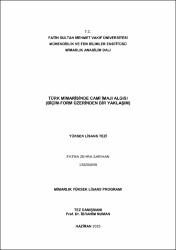| dc.contributor.advisor | Numan, İbrahim | |
| dc.contributor.author | Sarıhan, Fatma Zehra | |
| dc.date.accessioned | 2015-09-17T08:43:56Z | |
| dc.date.available | 2015-09-17T08:43:56Z | |
| dc.date.issued | 2015 | |
| dc.date.submitted | 2015 | |
| dc.identifier.citation | SARIHAN, Fatma Zehra, Türk Mimarisinde Cami İmajı Algısı : (Biçim-Form Üzerinden Bir Yaklaşım), Fatih Sultan Mehmet Vakıf Üniversitesi Mühendislik ve Fen Bilimleri Enstitüsü Mimarlık Anabilim Dalı, Yayımlanmamış Yüksek Lisans Tezi, 2015 | en_US |
| dc.identifier.uri | https://hdl.handle.net/11352/2233 | |
| dc.description.abstract | "Türk Mimarisinde Cami İmajı Algısı Biçim- Form Üzerinden Bir Yaklaşım" İsimli bu çalışma geleneksel dini yapılar ve mimari mekân algısının birbiri ile etkileşimi sonucu bir arada incelenmesi ile oluşmuştur. Çalışma algıya yöneliktir. Toplumun kültür ve dini değerleri ile oluşan cami yapılarının, aynı toplumdan gelen bir başka nesli üzerinde algısı ve etkisini ölçmektedir.
Başlangıçta cami mimarisinin oluşumu ve tarihçesi ile nasıl gelişim gösterdiği incelenmiştir. Türklerin cami yapılarında farklılaşması ile biçimsel özellikleri incelenmiştir. Bu noktada kültürün mimarinin şekillenmesindeki etkisi üzerinde durulmuştur. Selçuklu ve Osmanlı mimarisinde, gösterdiği gelişmeler ile ulaştığı son biçim incelenmiştir. Kırsal ve bölgesel şehir cami yapısı incelenerek işlevin biçimden daha önemli olduğu camilere, Türkiye’nin çeşitli bölgelerinden örnekler verilmiştir. Bu yapılarda da geleneksel mimarinin etkisi gösterilmiştir. Modern mimaride ise birbirinden farklı şekiller ile ortaya çıkan cami biçimleri olmuştur. Bu farklılaşmaların toplumun kültürüne ve geleneksel algısına etkileri tartışılmıştır.
İkinci bölümde, mimari mekânın algısı konusu incelenmiştir. Mekânın, algı üzerinden tanımlamaları ile algıda eğitim, kültür ve çevresel faktörlerin etkisi açıklanmıştır. Zamanın algıdaki etkisi ile geleneksel yapıların kendi dönemi ve sonraki dönemlerde farklı algılandığına varılmıştır. Algının kent ölçeğindeki bileşenleri mimari yapılanma sonucu oluşmuştur. Camilerin kentsel imgede bu bileşenlerden işaret öğesi olması üzerinden algıda netlik oluşturduğuna ulaşılmıştır. Caminin algılanmasındaki mimari bileşenler oluşturulmuştur.
Üçüncü bölümde, halkın zihninde oluşan cami imajını değerlendirmek için anket çalışması ile desteklenmiştir. 16-77 yaşlar arasında, 158 kişi ile anket çalışması yapılmış cami çizimi istenmiştir. Çizimleri yorumlamayı kolaylaştırıcı sorular ile anket oluşturulmuştur.
Dördüncü bölümde, anket çalışmalarının değerlendirmesi mimari mekân algısı üzerinden tartışılmıştır.
Sonuçtan da, geleneksel mimarinin değişen nesil üzerinde algısını koruduğu ve bundan başka oluşumlara önyargılı yaklaşıldığı sonucuna ulaşılmıştır, diyebiliriz. | en_US |
| dc.description.abstract | This study titled as “An Approach Related Shape- Form in Perception of Mosque İmage in Turkish Architecture “analyzed mosque together with spatial cognition in architecture space. This research is about the cognition of architectural space. Mosques were designed according to society, means they were represented with cultural and religious values. This study has been made clear that, how descent of the same society has been perceived mosques.
The first chapter has been answered questions that when mosques were appeared and how they were shaped and developed in Turkish traditional architecture. Architecture has affected by culture. This study has been mentioned progression of mosque shapes in Anatolian Seljuk and Ottoman Empire. And also, traditional rural mosque examples have been given from different region of Turkey. They have traditional Turkish architectural aspect. In modern architecture, there are many shapes that are differed from each other. In conclusion, it is discussed that differentiation based on cultural and traditional perception.
In the second chapter, the cognition of architectural space was explained. The space was identified in perception that it was depended on education, culture and environmental knowledge. Heritage buildings perception has been changed in their ages and future with time effects. The perception components in scale of city have appeared with architecture. According to being historical monument was made mosques sense clear. In the image of the city, historical or religious monuments are landmark. Architectural components have been generated for mosque.
In the third chapter; to have an idea of the public perception about mosque, questionnaire study was prepared. 158 people that their ages change between 16-77, have been participated in this questionnaire. First question was about drawing a mosque and the other questions were supported the first one for easy evaluation.
In the fourth chapter, the questionnaire has been evaluated according with architectural space perception and statistical data have been given.
In fifth chapter as a conclusion, we could say that conventional mosque image has been protected in common idea. | en_US |
| dc.language.iso | tur | en_US |
| dc.publisher | Fatih Sultan Mehmet Vakıf Üniversitesi, Mühendislik ve Fen Bilimleri Enstitüsü | en_US |
| dc.rights | info:eu-repo/semantics/openAccess | en_US |
| dc.subject | Geleneksel Camiler | en_US |
| dc.subject | Cami İmajı Algısı | en_US |
| dc.subject | Kentsel İmge | en_US |
| dc.subject | Biçim | en_US |
| dc.subject | Traditional Mosques | en_US |
| dc.subject | Perception of Mosque Image | en_US |
| dc.subject | The Image of City | en_US |
| dc.subject | Shape | en_US |
| dc.title | Türk Mimarisinde Cami İmajı Algısı : (Biçim-Form Üzerinden Bir Yaklaşım) | en_US |
| dc.type | masterThesis | en_US |
| dc.contributor.department | FSM Vakıf Üniversitesi, Mühendislik ve Fen Bilimleri Enstitüsü | en_US |
| dc.relation.publicationcategory | Tez | en_US |
| dc.contributor.institutionauthor | Sarıhan, Fatma Zehra | |



















